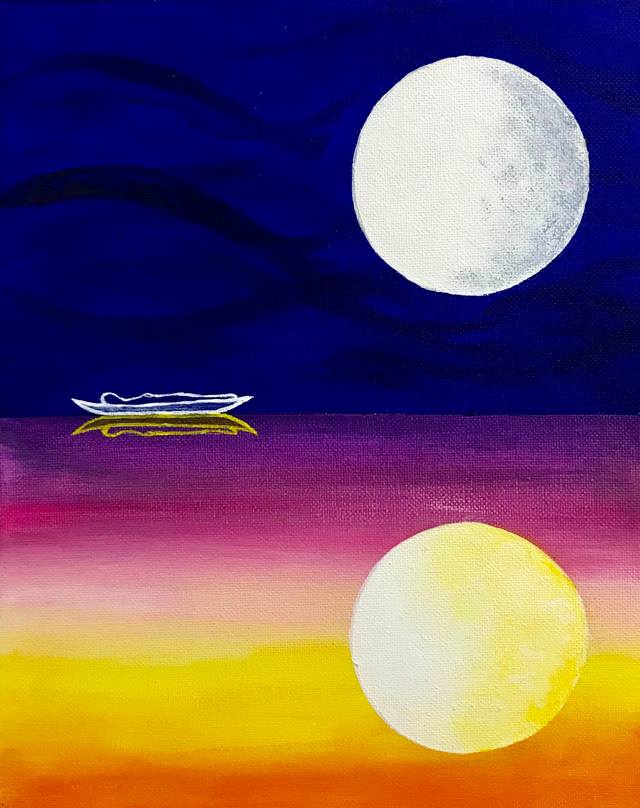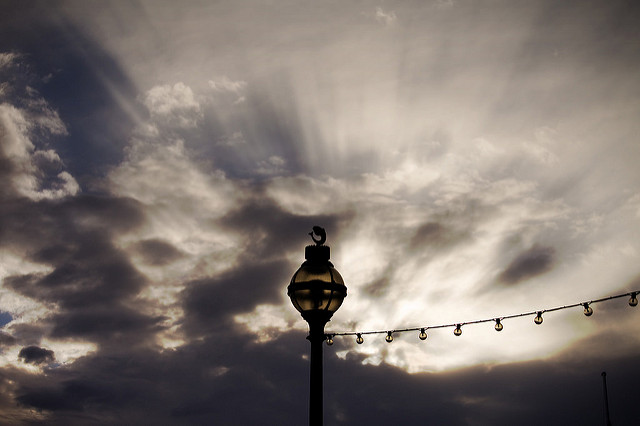夢(2)
ブライアン・クラーク著 咲耶まゆみ訳
By Brian Clark Translated by Mayumi Sakuya
English text to follow.
アストロロジーと夢
夢とアストロロジーに関して、私の考え方がある。それは、「アストロロジーは望遠鏡のようである一方、夢は顕微鏡のようである。従って、魂の中を覗き込むこれらの2つの方法を合わせると、隠れているものを明らかにし、非常に示唆に富んだものになる」ということ。これら2つの観察方法は、ネータルホロスコープと、夢の時間から作成した夢のチャートの2つのホロスコープを使う。
ネータルチャートは私たちの人生の夢に例えられる。大きな夢や、夢に出てくる個人的なストーリーなどだ。一方、夢のチャートは夜間の魂の声の記録を示す。
夢チャートは夢の時間を元に作るホロスコープだ。一般的にこれは夢から覚めた時か、夢を見た最良推定時間だ。経験を積んだドリーマーは、枕元の時計や腕時計の時間を夢日記につけることが多い。夢は魂が関心を寄せる今抱えている心配事や葛藤を表すスナップショットだ。夢チャートは夢の観点から読むので、アストロロジーのシンボルは、夢のシンボルを膨らませて見つけ出して、声を聞き取るための助けとなる。夢チャートはネータルチャートへのトランジットを体現するので、夢チャートを参照しながら出生ホロスコープを見ることで、日中(意識)の世界に対する夜の(無意識)の世界の関心事の領域が分かる。夢チャートは占星学のシンボルと同様に、アーキタイプであり、夢イメージとして個別に解釈できる。
夢にはパターンがある。夢は眠りに陥ってから約20分後に始まり、夜の間ずっと周期的に繰り返される。最初の夢の長さは5-10分だが、夜が進むにつれて40分まで続くことがある。睡眠が深まると、夢も深まる。午前3時から4時の間には、最深部の夢が掘り起こされる。また夢は目が覚めたときにも起こる。しかし、白日夢は前述の深い夢とは区別されることが多い。アストロロジーは、夜の夢のタイミングの考察を与えると同時に、天体周期や進行を見て、今のトランジットや人生のパターンに照らして夢を考察する方法も提供する。
昼と夜
1日の時間は、ハウスを運行する太陽の動きをほぼ示す。約2時間毎に太陽はホロスコープの一つのハウスに滞在する。ハウスの大きさは赤道地点でほぼ均等になるが、私たちは赤道から南か北に離れているため、ハウスの大きさは変わってくる。季節もまたこれに影響する。夏の太陽は冬よりも遅く沈む。しかしながら占星学は、地平線下のハウスを運行する太陽の元型的道のりと、この領域を通る間掘り起こされる可能性のある夢のイメージを教えてくれる。
夢は夜に属する。従って夢は、太陽が天空と冥界を分ける架空の線である地平線の下を旅する間に起きる。この太陽の夜の旅は、英雄の冥界下りだ。これをアストロロジーでは地平線下の6つのハウスで描く。太陽の沈む場所は、西の地平線のディセンダントだ。ここから私たちは夜と夢の中へ降りていく。太陽が沈み始めてから日の入りの約2時間後、太陽は6ハウスに滞在し、ここでは昼の世界から夜、そして夕方の準備のための生活儀式が行われる。
午後8時から10時には太陽は5ハウスを移動する。ここでは自我が、起き続けていようともがくが、やがて他の世界に屈し、眠りに陥る。そしてだいたい午後10時から深夜にかけて太陽は4ハウスに滞在し、過去や家族に関すること全てとしっかりとつながる。深夜になると、太陽は天底に辿り着き、占星学的に自己と他者を分ける子午線を超える。太陽が3ハウスに入ると、太陽は他者から向きを変え、自分と向き合って夢の時間のぼんやりとした世界を通り抜けて上昇する準備をする。
深夜から午前2時までの夢は、太陽が3ハウスを運行するときに起こる。午前2時と4時の間は、太陽は2ハウスにいて、大体午前4時から日の出の間に太陽は1ハウスにいる。これは、幼少期を示す出生チャートの四分円だ。従ってこの領域を通って昇る太陽は、過去の幻影に接するということであろう。白日夢は太陽が上昇点(アセンダント)付近にいるときに見る。
地平線に戻った太陽は、夜の影が一掃された景色の中に昇る。地平線を超えると、夜明けの女神エオスが最初の光をもたらすと同時に、夜の世界は昼に譲る。太陽が12ハウスを通ると、夜明けが昼の世界の到来を告げる。私たちは夢うつつの時、つまり、これら2つの世界の境界に留まる瞬間、夢は意識に引き戻されるようだ。太陽が12ハウスに入るとき、夢は意識が近づけるようにほんの一瞬の間留まってくれる。
12ハウス
古代人は12ハウスは「元に戻す・解く(undoing)」ハウスであることを知っていた。夜の世界から解放されるプロセスにふさわしい表現だ。夜から日中に入ることを示す12ハウスは天体たちが昇り、冥界の旅の間掘り出したことを振り返り、気づきをもたらしてくれる。12ハウスは、あちらの世界の隠喩的イメージをもたらすことから、夢に似ている。実際これは隠れ家のハウスで、ここに切り離されたイメージが日中から逃避してやってくる。
12ハウスで私たちは「夜の」経験を解く。それが夢からかもしれないし、家族の影や過去生のカルマからかもしれない。眠りから目覚めの移行領域は、内面のネガティブな事柄が日光に照らされる前に、現実世界を隠喩的に見通すことのできるパワフルな時間帯だ。夢研究家たちは、私たちは人生の1/3を睡眠に、そしてこの1/4の時間を夢に費やしていると指摘する。ということは、人生の1/12は夢を見ていることになる。地平線より上にある12ハウスは、夢を思い出し、夢風景にある内面の現実を可能な限り知るための環境だ。12ハウスは天体たちが夜の旅路から目覚め日中の世界に入る場所でもあるから、アストロロジャーたちはネータル12ハウスの天体を魂と内面世界の運び役として見ることが多い。
地平線下の太陽の通り道を考察することで、ホロスコープの日中の太陽と夜の太陽の違いも見えてくる。太陽は地平線上にいる間は輝き、人生の中心にあり、身体に命令を下し、覚醒している自我と調整する。夜になると太陽は見えないものの、まだそこには居る。基本性質に変わりはないが、眠りについているので、もはや自我意識の指示を受けることはない。より内観的で繊細な太陽エネルギーが夢を通して魂の意識を促す。太陽が地平線の下に降りると、太陽は夜の世界の影や幻影と遭遇する。それらは夢をとおして魂が吹き込まれる。初期のアストロロジーは、夜と昼の世界の区別を考慮していた。
古代ギリシャの占星学の観点からノクターナル(夜)とダイアーナル(昼)のホロスコープの違いは、「sect(教派・学派)」と呼ばれる伝統の中で尊重された。語源を見てみると、この言葉は、宗教団体独自の信念体系や習慣を意味にするようになった。ラテン語sectaは、思想の流派を意味する。この技法sectでは、日中の天体の配列やアーキタイプの配置は夜のそれらと異なるとしている。言い換えると、昼と夜のエネルギーは異なる教派から生まれるので、太陽が地平線上にあるときは、地平線下にあるときと比べて、存在の在り方の追求の仕方が異なるという事だ。
初期のアストロロジャーは、ルミナリ(光)と天体もこれらの2つの教派に分けた。太陽はもちろん木星と土星と共に日中の教派に入る。夜の女王である月は、運行速度の速いパーソナル惑星金星と火星と一緒に分類された。神話の中で常に両方の世界を行き来することが許されている水星は、夜と昼両方に属した。日の出前の星は昼、日没後の星は夜の仲間入りをした。どちらの教派にもつながっていながら、どちらとも協調していない。
ソーシャル惑星の木星と土星は、社会の働きと関係する。従って集団のモラル、倫理、信念、慣習、伝統、目標、法律などを司る。これらは社会の行動規範として掲げられ、順守が求められる。日中はこれらのエネルギーが太陽の衝動を支える。しかし、太陽が見えなくなると、その内観的な相方の月と仲間の金星と火星が優勢になる。ここ夜の世界では、より個人的な感情、感覚、印象、価値、喜び、好み、欲求、欲動、衝動が夢を通して太陽に知らされる。太陽が日中の世界に昇ると、太陽はまた輝くが、その時は内側の世界を知っている。通常、夢チャートはノクターナル・ホロスコープであり、月、金星、火星の配置がより着目される。
「夢(3)」に続く。
Dream (2)
by Brian Clark
Astrology and the Dream
One way I think about dreams and astrology is: to consider astrology as telescopic whereas the dream is microscopic; therefore the combination of these two ways of seeing into the soul can be unusually revealing. Astrologically these two points of view can be observed through two horoscopes: the natal horoscope and a dream chart constructed from the time of the dream.
The natal chart might be likened to the dream of our life, the big dream or our personal story of the dreamtime, while the dream chart represent a record of the soul’s voice during the night.
The dream chart is a horoscope cast for the approximate time of the dream; this is generally when you awaken from the dream or your best estimation of the time of the dream. For experienced dreamers the time is often noted in their dream journal as they note the time on their bedside clocks or watch. Modern digital recorders may have the time embedded. The dream is a snapshot, a present concern or a dilemma that interests the soul. The dream chart is read from the perspective of the dream and therefore the astrological symbols help amplify, identify and give voice to the dream symbols. Since the dream chart embodies the transits to the natal chart, referencing the dream chart to the natal horoscope identifies the areas of concern and interest in the night world (the unconscious) to the day world of consciousness. The dream chart can also be read separately, as astrological symbols, like dream images, are archetypal.
There are patterns to our dreaming. Dreams may start about 20 minutes after falling asleep and recur through the night in cycles. The first dream may be only 5 – 10 minutes long, but as the night progresses they may last up to 40 minutes. As sleep becomes deeper so do the dreams. Between 3 – 4 am the innermost dreams may be excavated. Dreams also occur on waking; however, the nature of waking dreams is often distinguishable from the earlier deeper dreams. Astrology offers us a way to think about the timing of the dream during the night, but also in the context of the current transits and over the course of our life’s patterns when planetary cycles and progressions are considered.
Day and Night
Hours of the day represent the Sun’s approximate movement through the houses. Approximately every two hours the Sun occupies another house of the horoscope. House size is just about equal at the Equator, but as we move north or south of the equator the houses vary in size. Seasons also affect this as the Sun sets later in the Summer than the Winter. However astrology offers us a way of thinking about the archetypal journey of the Sun through the houses below the horizon and what dream images might be excavated during its passage through this area.
Dreams belong to the night; therefore they occur while the Sun travels below the horizon, the imaginary line that separates sky and underworld. This nocturnal solar journey is the hero’s descent into the underworld, which astrology maps though the six houses underfoot. The setting place is the western horizon, the Descendant, where we descend into the night and the dream. From setting to approximately two hours after sunset, the Sun inhabits the 6th house, where the rituals of life are focused on the change from the day world to the night and the preparation for eventide.
From approximately 8 to 10 pm the Sun transits the 5th house where the ego self struggles to remain awake yet finally succumbs to the other world and the descent into sleep. From approximately 10 pm to midnight the Sun resides in the 4th house, anchored in all that is past and familial. At midnight the Sun reaches the nadir of its journey and crosses the meridian that astrologically separates self and other. As it enters the 3rd house the Sun turns away from otherness to face its self and prepare for its ascent through the shady world of the dreamtime.
Dreams between midnight and 2 am occur while the Sun is in the 3rd house; between 2 am and 4 am while the Sun is in the 2nd house and between roughly 4 am and sunrise while the Sun is in the 1st house. This is the quadrant of the natal chart that focuses on infancy; therefore the Sun’s ascent through this area is likely to connect with phantoms of the past. Waking dreams occur while the Sun is near the Ascendant.
Having reached the horizon once again, the Sun rises into view dispelling the shades of night. As it crosses over the horizon, the night world cedes to the day as Eos, the dawn goddess brings the first light. As the Sun passes into the 12th, dawning heralds the day world. Stirring from sleep we are more likely to bring to mind our dreams while we linger for a moment on the threshold between these two worlds. The dream stays behind momentarily available to consciousness as the Sun enters the 12th house.
The 12th House
Ancients knew the 12th house as the house of ‘undoing’, an apt description of the process of disengaging from the night world. As the house that marks the entry to the day out of the night, it is where the planets rise to offer us a mindful and reflective expression for what they have exhumed during their underworld journey. Hence the 12th house is similar to the dream in that it offers metaphoric images of the other world. In truth it is the house of asylum, where disenfranchised and disconnected images seek refuge from the day.
In the 12th house we undo the ‘night’ experience, whether that is in terms of the dream, the family shadow or past life karma. As the transitional zone between sleeping and waking, this metaphorically suggests a powerful time for seeing through the literal world, before the inner negatives become exposed by the sunlight. Dream researchers point out that we spend 1/3 of our lives sleeping and 1/4 of this time is spent dreaming. Therefore 1/12 of life is spent dreaming. Being above the horizon, the 12th house is an environment to re-member the dream and be as cognisant of the inner reality of the dreamscape as possible. Since the 12th house is the place where planets awaken out of their night journey into the day world, astrologers often see the natal 12th house planets as carriers of the soulful and inner life.
Considering the Sun’s passage below the horizon allows us to reflect on the difference between a diurnal Sun and a nocturnal one in the horoscope. While the Sun is above the horizon it shines, is central to life, dictates the bios and aligns with the waking ego. At night, it is unseen, yet still there. Its essence is the same yet is no longer directed by the conscious ego which now has fallen asleep. A more reflective and subtle solar energy promotes soul consciousness through dream. When the Sun descends under the horizon it encounters the shades and phantoms of the night world which become ensouled through the dream. Early astrological thought embraced the demarcation between the night and day worlds.
From the Hellenistic astrological perspective the distinction between nocturnal and diurnal horoscopes was respected in a tradition called ‘sect’. Etymologically the word has developed to mean a distinctive system of beliefs or observances, like a religious group. From the Latin secta, the word suggests a school of thought. Implied in the technique of sect is that the planetary alliances or archetypal arrangements during the day differ from the night; in other words, day and night energies arise from different schools of thought. When the Sun is above the horizon it pursues a different mode of being than when it is below.
Early astrologers also sectioned the luminaries and planets into these two schools of thought. The Sun of course was diurnal, along with Jupiter and Saturn, the social planets. Queen of the night, the Moon partnered with the faster moving and personal planets Venus and Mars. Mercury whose mythological nature had always given him permission to move between the worlds had both memberships, diurnal when the morning star and nocturnal as the evening star connected with both.
As social planets, Jupiter and Saturn are concerned with the functioning of society; hence are given rulership of the morals, ethics, beliefs, conventions, traditions, ambitions and laws of the group. These are the societal codes of conduct that are upheld and expected. During the day these energies support the solar impulse. But when the Sun is no longer visible, its reflective companion the Moon and its allies, Venus and Mars, become dominant. Here in the night world the more personal feelings, senses, impressions, values, pleasures, likes, desires, drives and urges are made known to the Sun through the dream. As it rises into the day world again the Sun shines, but now is aware of an inner world. Since the dream chart is usually nocturnal we might be more inclined to the placements of the Moon, Venus and Mars.
Continue to “Dream 3”.
関連記事
- 土星-天王星のサイクル: 2021年のウエイニング・スクエアに関する考察 (Part 2)
- 土星-天王星のサイクル: 2021年のウエイニング・スクエアに関する考察 (Part 1)
- パンとパンデミック:山羊座時代の愛(1) Pan and the Pandemic(1)
- パンとパンデミック:山羊座時代の愛(2) Pan and the Pandemic(2)
- 親密な関係 – 8ハウス Intimacy – The Eighth House(Part 1)
- 親密な関係 – 8ハウス Intimacy – The Eighth House(Part 2)
- ヘスティアとともにある家(ホーム) At Home with Hestia
- 夢 Dream(1)
- 夢 Dream(2)
- 夢 Dream(3)
Submit your review | |





